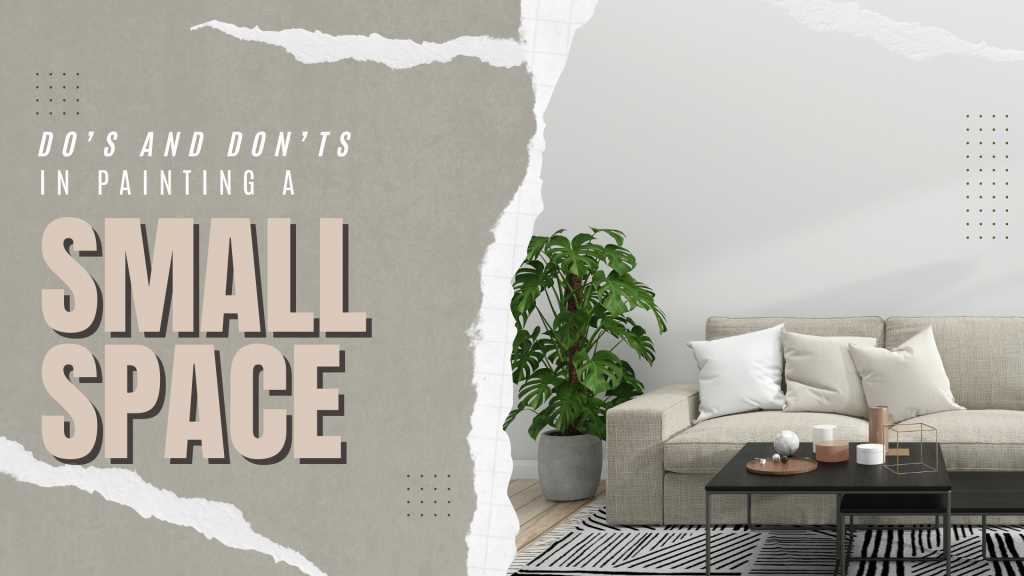Do’s and Don’ts In Painting A Small Space in Newtown, PA
Painting a small space can significantly impact the overall feel and appearance of your room.
It can make it feel larger, brighter, and more welcoming if done correctly.
However, small spaces also present unique challenges that require careful consideration.
So, if you’re looking for a guide to let you know what you should and should not be doing in painting a small space in your home, here’s something that could help!
Check out the Do’s and Don’ts In Painting A Small Space.
1. Choosing Colors
Do: Opt for Light and Neutral Colors
When you’re painting a small space, you should make sure to opt for light and neutral colors.
This is because light and neutral colors, such as whites, beiges, light grays, and/or pastels can help you visually maximize the space, essentially making a small space feel larger and more open.
This is because these colors reflect more light, which creates an illusion of a larger space, thus helping to expand the area visually.
Don’t: Overwhelm with Dark Colors
While dark colors can add depth and drama to a room, they tend to absorb light, making a small space feel even smaller and more enclosed.
If you love dark colors, consider using them on one accent wall or in smaller doses throughout the room to add depth without overwhelming the space.
2. Preparing the Space
Do: Make Thorough Preparations
In painting a small space, proper preparation becomes even more crucial.
Since you’re already working with limited space, you’d want to get everything else out of the way to avoid any unnecessary slip-ups, mess, or delays in your project.
For your other stuff that is built-in, you’d want to cover them up with drop cloths or plastic sheeting, to prevent paint drips and spills all over them.
Don’t: Skip the Prep Work
Rushing into painting without proper preparation can lead to disappointing results, such as uneven paint application, visible imperfections on the walls, and accidental paint on furniture and flooring.
Taking the time to prepare the space can save you from costly and time-consuming touch-ups later.
Remember that a properly prepared project is one that’s bound to be successful, and a poorly prepared one is, well, just the exact opposite of that!
3. The Right Tools and Techniques
Do: Use the Correct Tools and Techniques
Making sure that you invest in quality brushes and rollers suitable for the size of the space you’re painting will go a long way in your project.
Small rollers can help you paint tighter spaces more efficiently, while good quality brushes will provide a smooth finish around edges and in corners.
In painting, make sure to apply thin coats and let them dry properly first before moving on to the next one, to ensure a clean paint finish.
Lastly, mix all your paint in one container – this is called boxing your paint – to make sure that you get an even paint color and a consistent paint finish throughout your project.
Don’t: Improvise with Inappropriate Tools
Using the wrong tools, like a large roller in a tiny bathroom, can lead to uneven coverage and difficulty reaching into tight corners.
This could potentially result in a messy, unprofessional finish.
On the same note, employing incorrect painting techniques can cause streaks, drips, and a lack of uniformity in the paint application – leading to an abysmal painting project in general.
So, make sure to get acquainted with the right tools and techniques beforehand!
4. Maximizing the Illusion of Space
Do: Create Visual Continuity
By using the same color on walls, trim, and even ceilings, you can blur the boundaries between these surfaces, creating a sense of continuity that makes the room appear larger.
For added effect, choose furnishings and decor in colors that complement the walls to enhance the feeling of spaciousness.
Don’t: Fragment the Space with Contrasting Colors
High contrast between walls, trim, and ceiling can make a room feel smaller by drawing attention to the boundaries of the space.
Similarly, cluttering a small room with too many colors or patterns can make it feel cramped and chaotic.
5. Lighting and Finishing Touches
Do: Enhance with Lighting and Mirrors
Good lighting is essential in a small space, especially if you’re using lighter paint colors.
Combine natural light with layered artificial lighting to enhance the sense of space.
You could also incorporate mirrors can also be strategically placed to reflect light and create the illusion of depth.
Don’t: Neglect the Power of Accessories
While it’s important not to overcrowd a small space with too much furniture or decor, the right accessories can complement your paint job and enhance the room’s overall appeal.
So, make sure to tastefully choose items that complement your current design, to maintain a cohesive appeal but still add a dash of personality to your space!
If you need professional help with your interior/exterior painting project, PAINT Philadelphia can help.
Our home interior/exterior painting services are available in Newtown, Holland, and Richboro, PA.
Call us today at (267)682-8377 for a FREE painting estimate.
Related: Handy DIY Tips For Painting Your Gaming Room in Holland, PA
Materials To Get For Painting Your Kid’s Bedroom in Newtown, PA

Andrew Tomasetti is not just a painting contractor, he is the owner of Paint Philadephia; a painting company in the greater Philadephia area that services the Holland, Newtown, Churchville, Yardley, Richboro areas.
Paint Philadephia is an interior, exterior and cabinet painting company that offers their customers top-notch services and their exclusive “On Time, On Dime” guarantee. They take a holistic view to all of their paint jobs offering free color and design consults, test samples, free touch ups on all painting projects, and warranties on all of their work.
Andrew Tomasetti is both a veteran and an engineer. His passion for hands-on work comes from his father and uncle and runs deep in his veins.

